technical specifications FIAT IDEA 2009 1.G Owners Manual
[x] Cancel search | Manufacturer: FIAT, Model Year: 2009, Model line: IDEA, Model: FIAT IDEA 2009 1.GPages: 210, PDF Size: 3.62 MB
Page 105 of 210
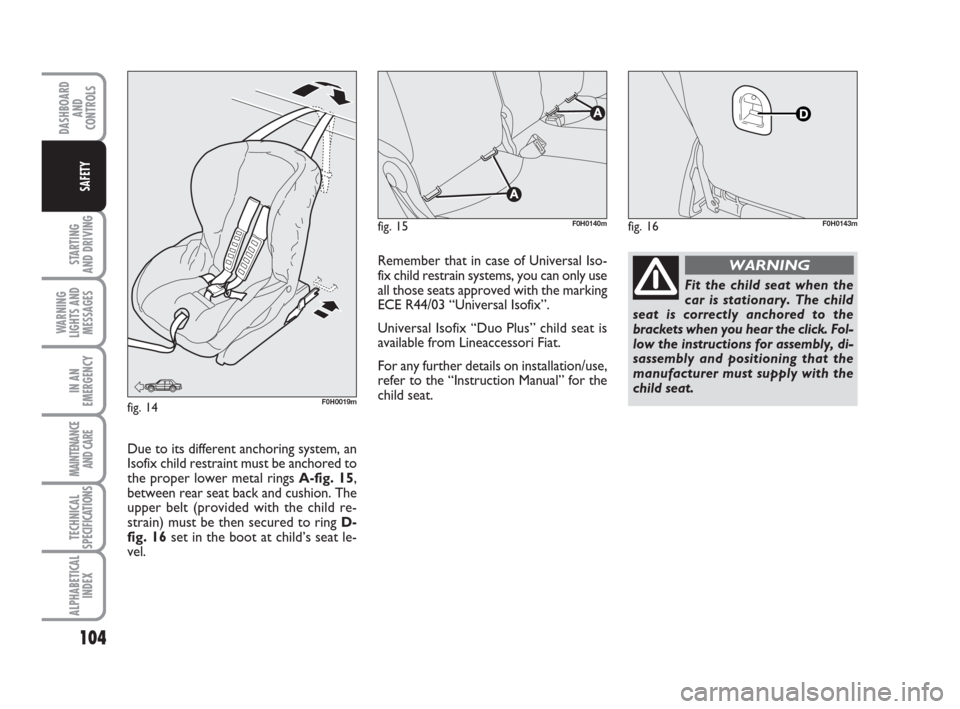
104
STARTING
AND DRIVING
WARNING
LIGHTS AND
MESSAGES
IN AN
EMERGENCY
MAINTENANCE
AND CARE
TECHNICAL
SPECIFICATIONS
ALPHABETICAL
INDEX
DASHBOARD
AND
CONTROLS
SAFETY
fig. 15F0H0140m
Fit the child seat when the
car is stationary. The child
seat is correctly anchored to the
brackets when you hear the click. Fol-
low the instructions for assembly, di-
sassembly and positioning that the
manufacturer must supply with the
child seat.
WARNING
fig. 14F0H0019m
Due to its different anchoring system, an
Isofix child restraint must be anchored to
the proper lower metal rings A-fig. 15,
between rear seat back and cushion. The
upper belt (provided with the child re-
strain) must be then secured to ring D-
fig. 16set in the boot at child’s seat le-
vel.
fig. 16F0H0143m
Remember that in case of Universal Iso-
fix child restrain systems, you can only use
all those seats approved with the marking
ECE R44/03 “Universal Isofix”.
Universal Isofix “Duo Plus” child seat is
available from Lineaccessori Fiat.
For any further details on installation/use,
refer to the “Instruction Manual” for the
child seat.
Page 106 of 210

105
STARTING
AND DRIVING
WARNING
LIGHTS AND
MESSAGES
IN AN
EMERGENCY
MAINTENANCE
AND CARE
TECHNICAL
SPECIFICATIONS
ALPHABETICAL
INDEX
DASHBOARD
AND
CONTROLS
SAFETY
PASSENGER SEAT COMPLIANCE WITH REGULATIONS ON UNIVERSAL ISOFIX CHILD SEAT USE
The table below, according to ECE 16 European Directive, shows the different installation possibilities of Isofix restraint systems
on seats fitted with Universal Isofix fasteners.
Weight group Orientation Isofix position class
seat Isofix size side rear
Group 0 to 10 kg
Group 0+ up to 13 kg
Group I from 9
up to 18 kg
Facing backwards
Facing backwards
Facing backwards
Facing backwards
Facing backwards
Facing backwards
Facing forwards
Facing forwards
Facing forwardsE
E
D
C
D
C
B
B1
AIL
IL
IL
IL (*)
IL
IL (*)
IUF
IUF
IUF
IUF suitable for Isofix child restraint systems to be set facing forwards, universal class (fitted with third upper fastener), ap-
proved for the weight group.
IL: suitable for special child restraint systems. Isofix type suitable and tested for this type of car. The seat may be installed by
moving the front seat forward.
(*) Arrange the Isofix seat with the front seat in all up position.
Page 107 of 210
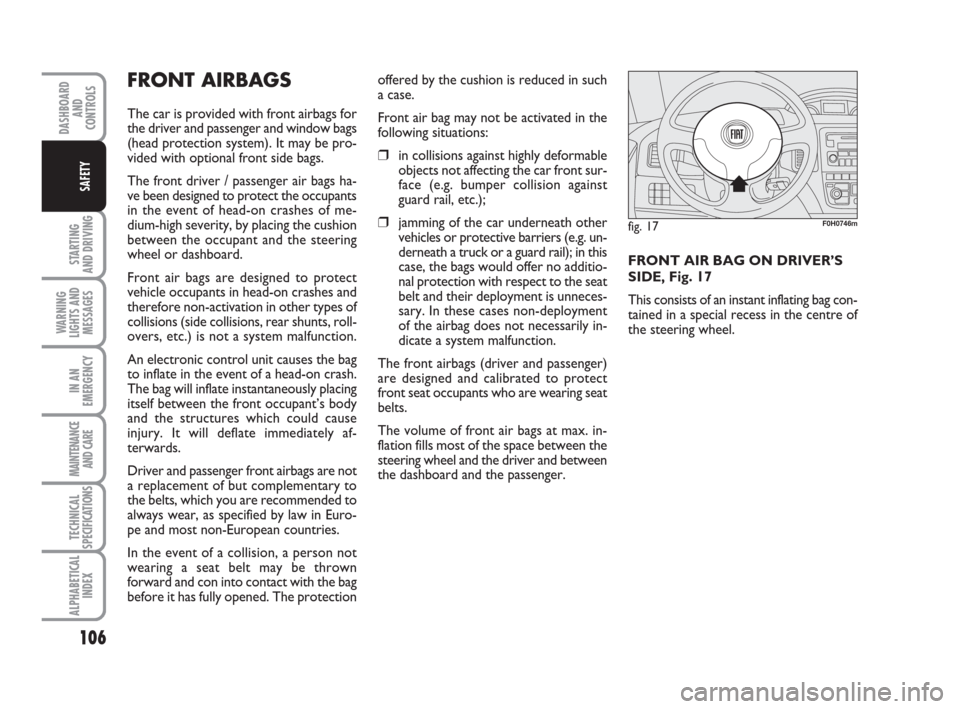
106
STARTING
AND DRIVING
WARNING
LIGHTS AND
MESSAGES
IN AN
EMERGENCY
MAINTENANCE
AND CARE
TECHNICAL
SPECIFICATIONS
ALPHABETICAL
INDEX
DASHBOARD
AND
CONTROLS
SAFETY
FRONT AIRBAGS
The car is provided with front airbags for
the driver and passenger and window bags
(head protection system). It may be pro-
vided with optional front side bags.
The front driver / passenger air bags ha-
ve been designed to protect the occupants
in the event of head-on crashes of me-
dium-high severity, by placing the cushion
between the occupant and the steering
wheel or dashboard.
Front air bags are designed to protect
vehicle occupants in head-on crashes and
therefore non-activation in other types of
collisions (side collisions, rear shunts, roll-
overs, etc.) is not a system malfunction.
An electronic control unit causes the bag
to inflate in the event of a head-on crash.
The bag will inflate instantaneously placing
itself between the front occupant’s body
and the structures which could cause
injury. It will deflate immediately af-
terwards.
Driver and passenger front airbags are not
a replacement of but complementary to
the belts, which you are recommended to
always wear, as specified by law in Euro-
pe and most non-European countries.
In the event of a collision, a person not
wearing a seat belt may be thrown
forward and con into contact with the bag
before it has fully opened. The protectionoffered by the cushion is reduced in such
a case.
Front air bag may not be activated in the
following situations:
❒in collisions against highly deformable
objects not affecting the car front sur-
face (e.g. bumper collision against
guard rail, etc.);
❒jamming of the car underneath other
vehicles or protective barriers (e.g. un-
derneath a truck or a guard rail); in this
case, the bags would offer no additio-
nal protection with respect to the seat
belt and their deployment is unneces-
sary. In these cases non-deployment
of the airbag does not necessarily in-
dicate a system malfunction.
The front airbags (driver and passenger)
are designed and calibrated to protect
front seat occupants who are wearing seat
belts.
The volume of front air bags at max. in-
flation fills most of the space between the
steering wheel and the driver and between
the dashboard and the passenger.FRONT AIR BAG ON DRIVER’S
SIDE, Fig. 17
This consists of an instant inflating bag con-
tained in a special recess in the centre of
the steering wheel.fig. 17F0H0746m
Page 108 of 210
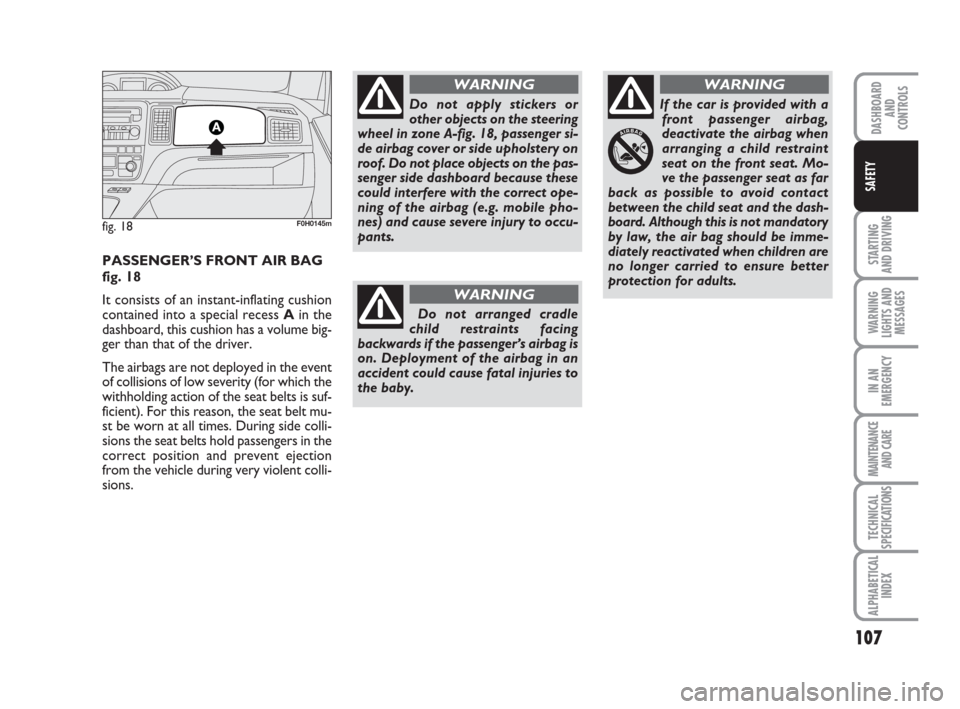
107
STARTING
AND DRIVING
WARNING
LIGHTS AND
MESSAGES
IN AN
EMERGENCY
MAINTENANCE
AND CARE
TECHNICAL
SPECIFICATIONS
ALPHABETICAL
INDEX
DASHBOARD
AND
CONTROLS
SAFETY
fig. 18F0H0145m
PASSENGER’S FRONT AIR BAG
fig. 18
It consists of an instant-inflating cushion
contained into a special recess Ain the
dashboard, this cushion has a volume big-
ger than that of the driver.
The airbags are not deployed in the event
of collisions of low severity (for which the
withholding action of the seat belts is suf-
ficient). For this reason, the seat belt mu-
st be worn at all times. During side colli-
sions the seat belts hold passengers in the
correct position and prevent ejection
from the vehicle during very violent colli-
sions.
Do not apply stickers or
other objects on the steering
wheel in zone A-fig. 18, passenger si-
de airbag cover or side upholstery on
roof. Do not place objects on the pas-
senger side dashboard because these
could interfere with the correct ope-
ning of the airbag (e.g. mobile pho-
nes) and cause severe injury to occu-
pants.
WARNING
Do not arranged cradle
child restraints facing
backwards if the passenger’s airbag is
on. Deployment of the airbag in an
accident could cause fatal injuries to
the baby.
WARNING
If the car is provided with a
front passenger airbag,
deactivate the airbag when
arranging a child restraint
seat on the front seat. Mo-
ve the passenger seat as far
back as possible to avoid contact
between the child seat and the dash-
board. Although this is not mandatory
by law, the air bag should be imme-
diately reactivated when children are
no longer carried to ensure better
protection for adults.
WARNING
Page 109 of 210
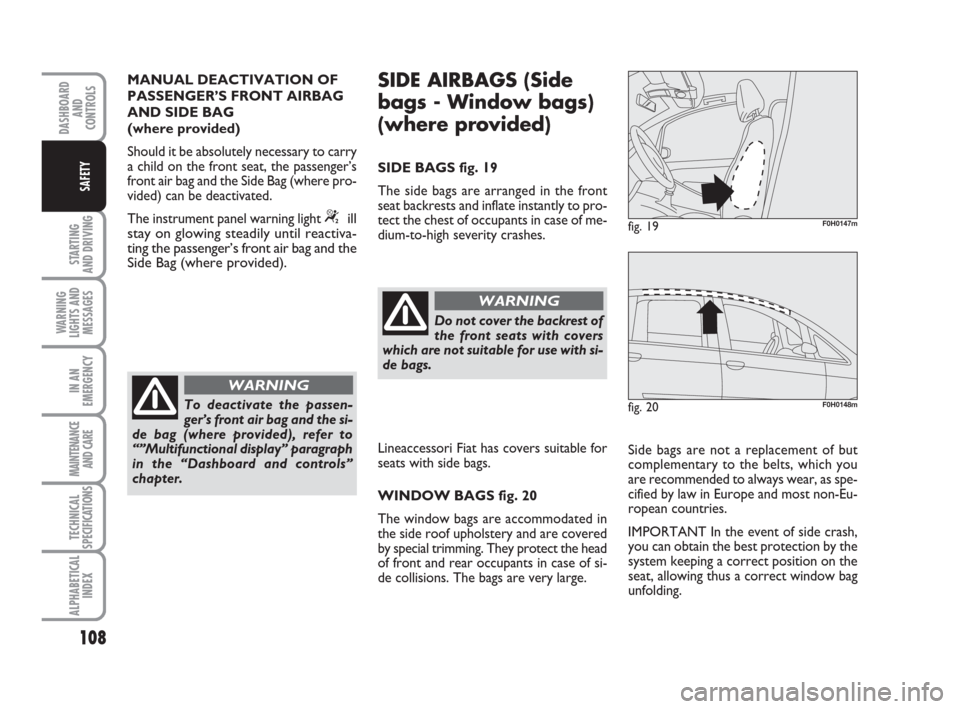
108
STARTING
AND DRIVING
WARNING
LIGHTS AND
MESSAGES
IN AN
EMERGENCY
MAINTENANCE
AND CARE
TECHNICAL
SPECIFICATIONS
ALPHABETICAL
INDEX
DASHBOARD
AND
CONTROLS
SAFETY
To deactivate the passen-
ger’s front air bag and the si-
de bag (where provided), refer to
“”Multifunctional display” paragraph
in the “Dashboard and controls”
chapter.
WARNING
MANUAL DEACTIVATION OF
PASSENGER’S FRONT AIRBAG
AND SIDE BAG
(where provided)
Should it be absolutely necessary to carry
a child on the front seat, the passenger’s
front air bag and the Side Bag (where pro-
vided) can be deactivated.
The instrument panel warning light
“ill
stay on glowing steadily until reactiva-
ting the passenger’s front air bag and the
Side Bag (where provided).
SIDE AIRBAGS (Side
bags - Window bags)
(where provided)
SIDE BAGS fig. 19
The side bags are arranged in the front
seat backrests and inflate instantly to pro-
tect the chest of occupants in case of me-
dium-to-high severity crashes.
Side bags are not a replacement of but
complementary to the belts, which you
are recommended to always wear, as spe-
cified by law in Europe and most non-Eu-
ropean countries.
IMPORTANT In the event of side crash,
you can obtain the best protection by the
system keeping a correct position on the
seat, allowing thus a correct window bag
unfolding.
Do not cover the backrest of
the front seats with covers
which are not suitable for use with si-
de bags.
WARNING
Lineaccessori Fiat has covers suitable for
seats with side bags.
WINDOW BAGS fig. 20
The window bags are accommodated in
the side roof upholstery and are covered
by special trimming. They protect the head
of front and rear occupants in case of si-
de collisions. The bags are very large.
fig. 19F0H0147m
fig. 20F0H0148m
Page 110 of 210
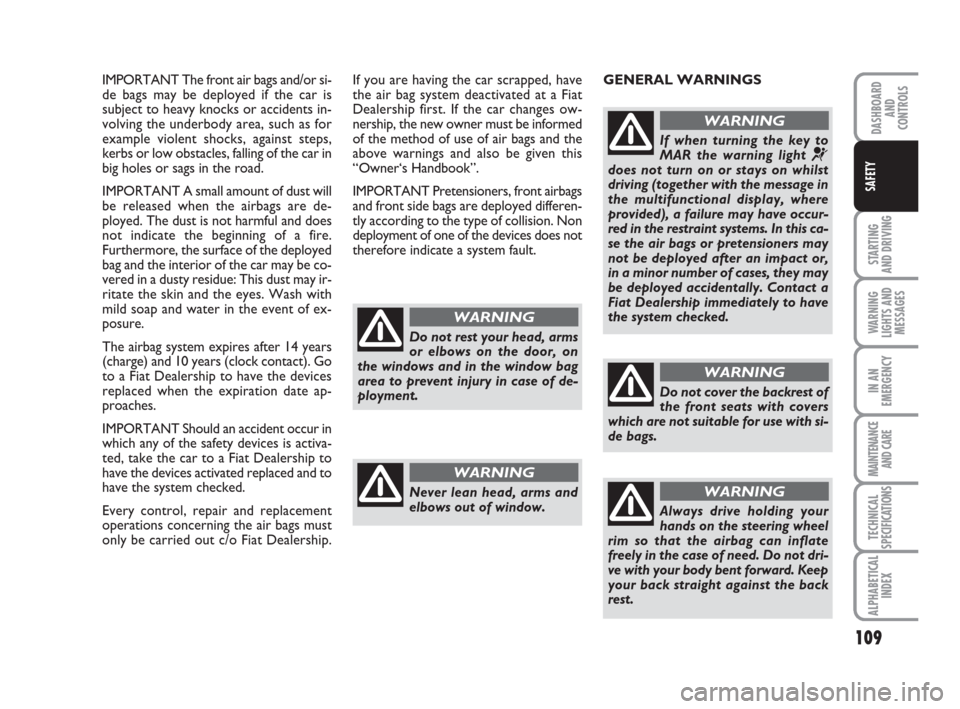
109
STARTING
AND DRIVING
WARNING
LIGHTS AND
MESSAGES
IN AN
EMERGENCY
MAINTENANCE
AND CARE
TECHNICAL
SPECIFICATIONS
ALPHABETICAL
INDEX
DASHBOARD
AND
CONTROLS
SAFETY
IMPORTANT The front air bags and/or si-
de bags may be deployed if the car is
subject to heavy knocks or accidents in-
volving the underbody area, such as for
example violent shocks, against steps,
kerbs or low obstacles, falling of the car in
big holes or sags in the road.
IMPORTANT A small amount of dust will
be released when the airbags are de-
ployed. The dust is not harmful and does
not indicate the beginning of a fire.
Furthermore, the surface of the deployed
bag and the interior of the car may be co-
vered in a dusty residue: This dust may ir-
ritate the skin and the eyes. Wash with
mild soap and water in the event of ex-
posure.
The airbag system expires after 14 years
(charge) and 10 years (clock contact). Go
to a Fiat Dealership to have the devices
replaced when the expiration date ap-
proaches.
IMPORTANT Should an accident occur in
which any of the safety devices is activa-
ted, take the car to a Fiat Dealership to
have the devices activated replaced and to
have the system checked.
Every control, repair and replacement
operations concerning the air bags must
only be carried out c/o Fiat Dealership.If you are having the car scrapped, have
the air bag system deactivated at a Fiat
Dealership first. If the car changes ow-
nership, the new owner must be informed
of the method of use of air bags and the
above warnings and also be given this
“Owner‘s Handbook”.
IMPORTANT Pretensioners, front airbags
and front side bags are deployed differen-
tly according to the type of collision. Non
deployment of one of the devices does not
therefore indicate a system fault.
Do not rest your head, arms
or elbows on the door, on
the windows and in the window bag
area to prevent injury in case of de-
ployment.
WARNING
Never lean head, arms and
elbows out of window.
WARNING
If when turning the key to
MAR the warning light
¬does not turn on or stays on whilst
driving (together with the message in
the multifunctional display, where
provided), a failure may have occur-
red in the restraint systems. In this ca-
se the air bags or pretensioners may
not be deployed after an impact or,
in a minor number of cases, they may
be deployed accidentally. Contact a
Fiat Dealership immediately to have
the system checked.
WARNING
GENERAL WARNINGS
Do not cover the backrest of
the front seats with covers
which are not suitable for use with si-
de bags.
WARNING
Always drive holding your
hands on the steering wheel
rim so that the airbag can inflate
freely in the case of need. Do not dri-
ve with your body bent forward. Keep
your back straight against the back
rest.
WARNING
Page 111 of 210
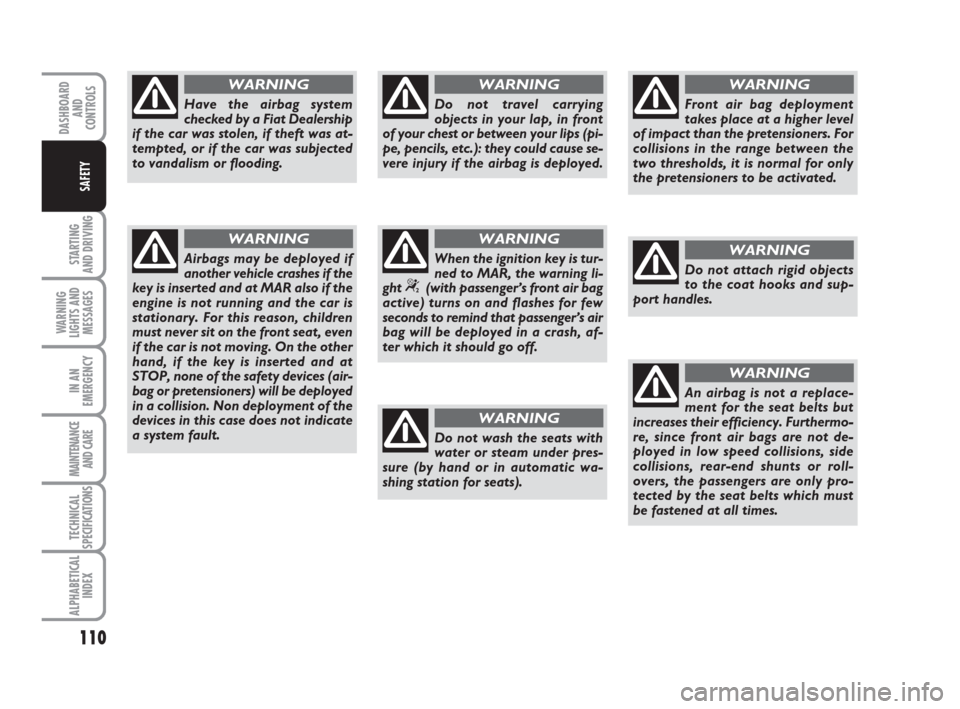
110
STARTING
AND DRIVING
WARNING
LIGHTS AND
MESSAGES
IN AN
EMERGENCY
MAINTENANCE
AND CARE
TECHNICAL
SPECIFICATIONS
ALPHABETICAL
INDEX
DASHBOARD
AND
CONTROLS
SAFETY
Have the airbag system
checked by a Fiat Dealership
if the car was stolen, if theft was at-
tempted, or if the car was subjected
to vandalism or flooding.
WARNING
Airbags may be deployed if
another vehicle crashes if the
key is inserted and at MAR also if the
engine is not running and the car is
stationary. For this reason, children
must never sit on the front seat, even
if the car is not moving. On the other
hand, if the key is inserted and at
STOP, none of the safety devices (air-
bag or pretensioners) will be deployed
in a collision. Non deployment of the
devices in this case does not indicate
a system fault.
WARNING
Do not travel carrying
objects in your lap, in front
of your chest or between your lips (pi-
pe, pencils, etc.): they could cause se-
vere injury if the airbag is deployed.
WARNING
When the ignition key is tur-
ned to MAR, the warning li-
ght
“(with passenger’s front air bag
active) turns on and flashes for few
seconds to remind that passenger’s air
bag will be deployed in a crash, af-
ter which it should go off.
WARNING
Do not wash the seats with
water or steam under pres-
sure (by hand or in automatic wa-
shing station for seats).
WARNING
Front air bag deployment
takes place at a higher level
of impact than the pretensioners. For
collisions in the range between the
two thresholds, it is normal for only
the pretensioners to be activated.
WARNING
Do not attach rigid objects
to the coat hooks and sup-
port handles.
WARNING
An airbag is not a replace-
ment for the seat belts but
increases their efficiency. Furthermo-
re, since front air bags are not de-
ployed in low speed collisions, side
collisions, rear-end shunts or roll-
overs, the passengers are only pro-
tected by the seat belts which must
be fastened at all times.
WARNING
Page 112 of 210
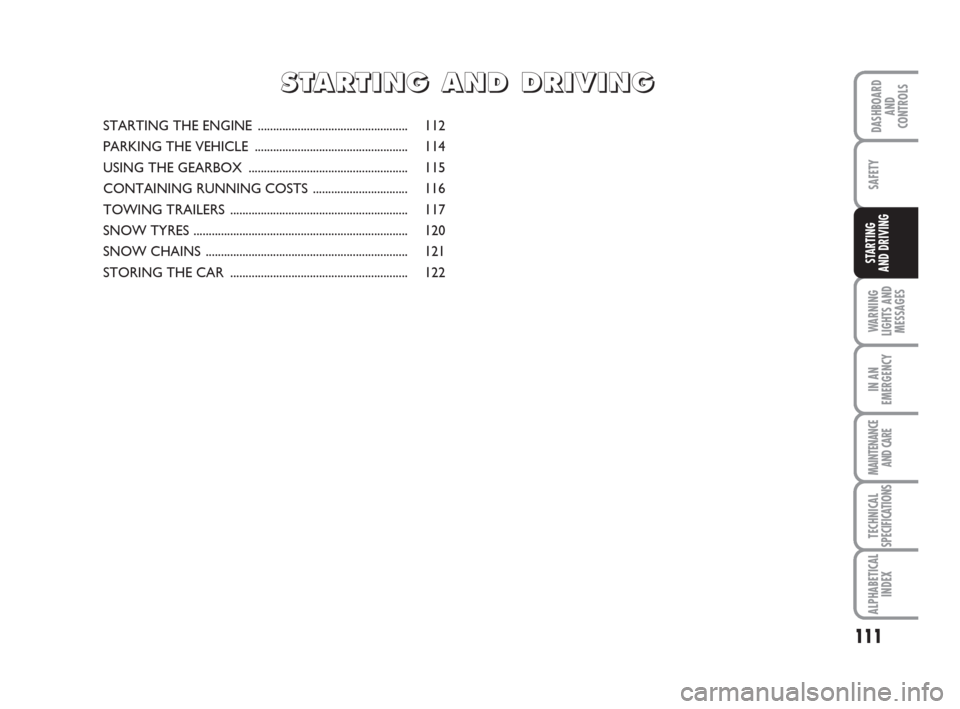
111
WARNING
LIGHTS AND
MESSAGES
IN AN
EMERGENCY
MAINTENANCE
AND CARE
TECHNICAL
SPECIFICATIONS
ALPHABETICAL
INDEX
DASHBOARD
AND
CONTROLS
SAFETY
STARTING
AND DRIVING
STARTING THE ENGINE ................................................. 112
PARKING THE VEHICLE .................................................. 114
USING THE GEARBOX .................................................... 115
CONTAINING RUNNING COSTS ............................... 116
TOWING TRAILERS .......................................................... 117
SNOW TYRES ...................................................................... 120
SNOW CHAINS .................................................................. 121
STORING THE CAR .......................................................... 122
S S
T T
A A
R R
T T
I I
N N
G G
A A
N N
D D
D D
R R
I I
V V
I I
N N
G G
Page 113 of 210
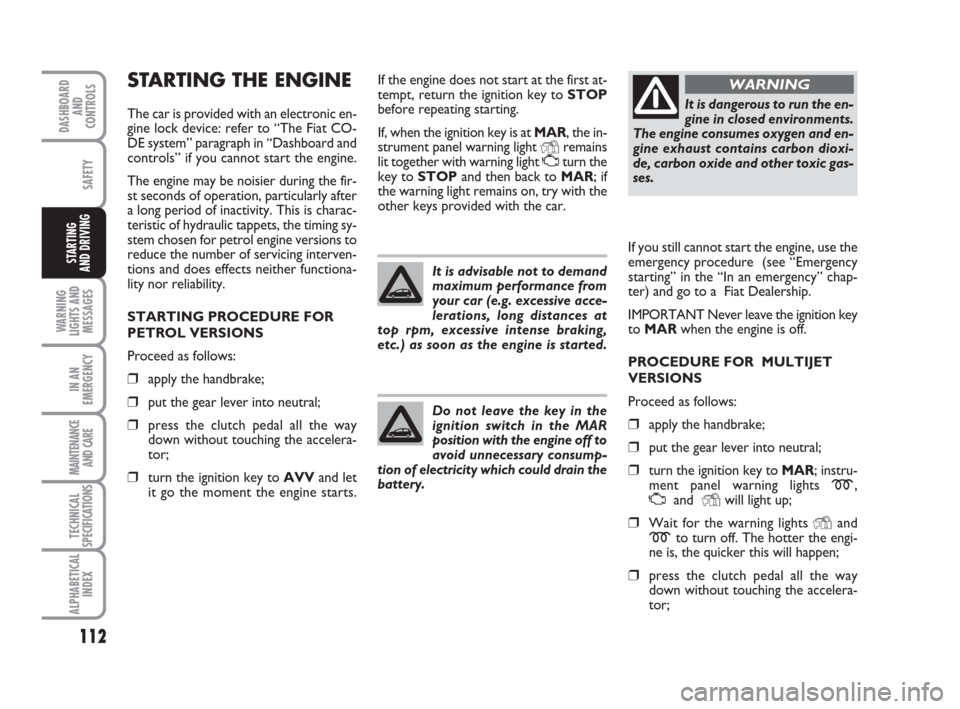
112
WARNING
LIGHTS AND
MESSAGES
IN AN
EMERGENCY
MAINTENANCE
AND CARE
TECHNICAL
SPECIFICATIONS
ALPHABETICAL
INDEX
DASHBOARD
AND
CONTROLS
SAFETY
STARTING
AND DRIVING
STARTING THE ENGINE
The car is provided with an electronic en-
gine lock device: refer to “The Fiat CO-
DE system” paragraph in “Dashboard and
controls” if you cannot start the engine.
The engine may be noisier during the fir-
st seconds of operation, particularly after
a long period of inactivity. This is charac-
teristic of hydraulic tappets, the timing sy-
stem chosen for petrol engine versions to
reduce the number of servicing interven-
tions and does effects neither functiona-
lity nor reliability.
STARTING PROCEDURE FOR
PETROL VERSIONS
Proceed as follows:
❒apply the handbrake;
❒put the gear lever into neutral;
❒press the clutch pedal all the way
down without touching the accelera-
tor;
❒turn the ignition key to AVVand let
it go the moment the engine starts.
It is dangerous to run the en-
gine in closed environments.
The engine consumes oxygen and en-
gine exhaust contains carbon dioxi-
de, carbon oxide and other toxic gas-
ses.
WARNINGIf the engine does not start at the first at-
tempt, return the ignition key to STOP
before repeating starting.
If, when the ignition key is at MAR, the in-
strument panel warning light
Yremains
lit together with warning light Uturn the
key to STOPand then back to MAR; if
the warning light remains on, try with the
other keys provided with the car.
If you still cannot start the engine, use the
emergency procedure (see “Emergency
starting” in the “In an emergency” chap-
ter) and go to a Fiat Dealership.
IMPORTANT Never leave the ignition key
to MARwhen the engine is off.
PROCEDURE FOR MULTIJET
VERSIONS
Proceed as follows:
❒apply the handbrake;
❒put the gear lever into neutral;
❒turn the ignition key to MAR; instru-
ment panel warning lights m,
Uand
Ywill light up;
❒Wait for the warning lights Yand
mto turn off. The hotter the engi-
ne is, the quicker this will happen;
❒press the clutch pedal all the way
down without touching the accelera-
tor; It is advisable not to demand
maximum performance from
your car (e.g. excessive acce-
lerations, long distances at
top rpm, excessive intense braking,
etc.) as soon as the engine is started.
Do not leave the key in the
ignition switch in the MAR
position with the engine off to
avoid unnecessary consump-
tion of electricity which could drain the
battery.
Page 114 of 210
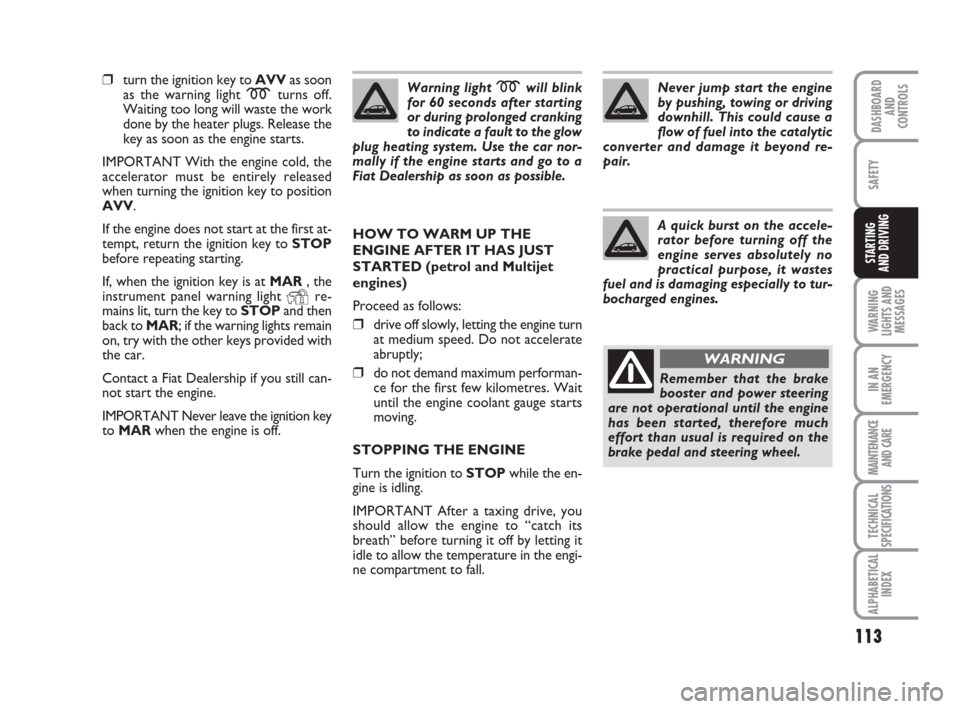
113
WARNING
LIGHTS AND
MESSAGES
IN AN
EMERGENCY
MAINTENANCE
AND CARE
TECHNICAL
SPECIFICATIONS
ALPHABETICAL
INDEX
DASHBOARD
AND
CONTROLS
SAFETY
STARTING
AND DRIVING
❒turn the ignition key to AVVas soon
as the warning light mturns off.
Waiting too long will waste the work
done by the heater plugs. Release the
key as soon as the engine starts.
IMPORTANT With the engine cold, the
accelerator must be entirely released
when turning the ignition key to position
AVV.
If the engine does not start at the first at-
tempt, return the ignition key to STOP
before repeating starting.
If, when the ignition key is at MAR, the
instrument panel warning light
Yre-
mains lit, turn the key to STOPand then
back to MAR; if the warning lights remain
on, try with the other keys provided with
the car.
Contact a Fiat Dealership if you still can-
not start the engine.
IMPORTANT Never leave the ignition key
to MARwhen the engine is off. Warning light
mwill blink
for 60 seconds after starting
or during prolonged cranking
to indicate a fault to the glow
plug heating system. Use the car nor-
mally if the engine starts and go to a
Fiat Dealership as soon as possible.
HOW TO WARM UP THE
ENGINE AFTER IT HAS JUST
STARTED (petrol and Multijet
engines)
Proceed as follows:
❒drive off slowly, letting the engine turn
at medium speed. Do not accelerate
abruptly;
❒do not demand maximum performan-
ce for the first few kilometres. Wait
until the engine coolant gauge starts
moving.
STOPPING THE ENGINE
Turn the ignition to STOPwhile the en-
gine is idling.
IMPORTANT After a taxing drive, you
should allow the engine to “catch its
breath” before turning it off by letting it
idle to allow the temperature in the engi-
ne compartment to fall. Never jump start the engine
by pushing, towing or driving
downhill. This could cause a
flow of fuel into the catalytic
converter and damage it beyond re-
pair.
A quick burst on the accele-
rator before turning off the
engine serves absolutely no
practical purpose, it wastes
fuel and is damaging especially to tur-
bocharged engines.
Remember that the brake
booster and power steering
are not operational until the engine
has been started, therefore much
effort than usual is required on the
brake pedal and steering wheel.
WARNING